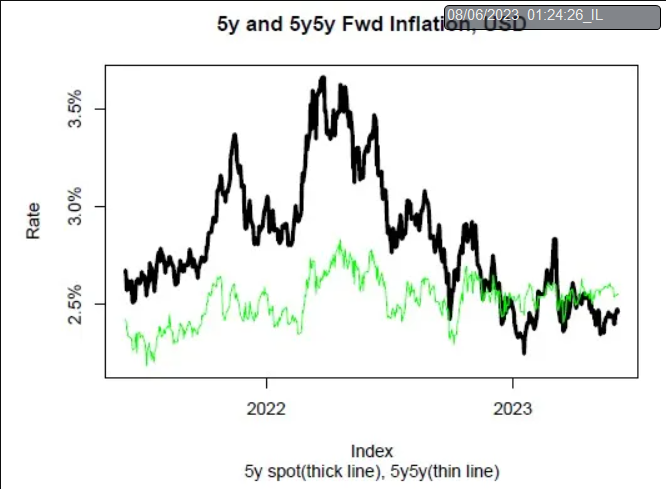Today we are going to geek out on inflation derivatives a little more. Since early 2022, just after the Russian invasion of Ukraine, 10y US CPI swaps have fallen from about 3.15% to around 2.50% (see chart, source Bloomberg).

This is, on its face, pretty remarkable since median inflation during this time has risen from 4.76% in February 2022 to 7.20% in February 2023, and has now ebbed all the way to 6.98%. Core inflation has fallen farther, largely because of the drag from Health Insurance, but is still at 5.5%.
Headline inflation has plummeted to 4.9% y/y. There are clearly some base effects that will pull those numbers lower from here, but 10y CPI swaps at 2.50% still looks pretty sporty. After all, you can pay fixed and receive inflation on CPI swaps (aka ‘buying’ the swap) and enjoy positive carry as long as the monthlies are consistently above 0.20% NSA, and six of the last nine have been.
Unfortunately, what you also get when you buy the swap is the negative mark-to-market as 10-year expectations decline. A cursory glance at the market would suggest that the Fed has successfully stuffed the inflation expectations cat back in the bag.
Back in 2018, the rolling-10-year-compounded realized inflation rate got as low as 1.37% (granted, this measured from just before the GFC), and even a few years ago it was around 1.60%. If the Fed is putting the inflation genie back in the bottle (I’m working on getting my metaphor count up), then gosh – maybe there’s more downside to inflation swaps.
Or maybe not. Look at the following chart, which breaks down the 10-year CPI swap into the 5-year CPI swap and a 5-year swap, starting in 5 years. We call the former a 5-year “spot” CPI swap; the latter is a 5y5y forward CPI swap. The 5y5y shows us the rate you could lock in today, paying fixed for 5 years and receiving actual realized inflation from June 2028-June 2033.

These two rates have a relationship that
sqrt[(1+5y rate)(1+5y5y)] – 1 = 10y CPI rate
In other words, you can pay fixed and receive inflation in one of two ways: you can pay the 10y rate and receive inflation, or you can pay the 5y rate and receive inflation for 5 years, and simultaneously lock in the rate where you would do the same transaction in 5 years.
Notice that almost all of the improvement in the 10-year rate since early 2022 is in the spot 5-year rate. Now, the spot rate is always more volatile than the forward, because energy is very volatile in the short term but mean-reverting in the long term. For this reason, policymakers often obsess on the 5y5y, which is perceived to be long enough for the energy volatility to wash out.[1] But in this case, pretty much all of the improvement in inflation quotes is coming from the front of the curve. In other words, if inflation expectations were “unanchored” (at least judging from the market, which as we know is a terrible measure of expectations) back in 2022 then they still are, 500bps of tightening later.
That being said, it’s hard to get terribly concerned about this supposed unmooring because if you back up a little farther it’s obvious that market pricing of longer-term inflation is still damaged from way before COVID. The chart below shows 5y5y CPI going back basically to the beginning of the inflation derivatives market.

From 2003 to 2014, 5y5y was never far from 2.75%-3.00%. There were occasional forays down to 2.5%, and occasional jaunts up to 3.25%, but other than the volatility around the GFC it never varied far from that. Today’s level of 2.58% would be at the lower end of the historical range prior to 2015, and at the upper end of the historical range from 2015 to present.
What happened in late 2014? Well, the dollar soared and oil prices crashed from 100 to 50 in a short period of time. Somehow, this led to a structural change in the shape of the inflation curve. In the old language we used to use, the “risk premium” of 5y5y over spot 5y got squeezed out. I suspect it was because of the structural change to lower volatilities, which lessened the value of the ‘tail’ option in long-dated inflation. But…I may be attributing too much sophistication to the market.
Whatever the reason, long-dated inflation quotes appear to me to still be very low. If the Fed achieves a 2% target for PCE, that’s 2.25% or so on CPI and you lose 33bps versus the 2.58% forward. If the Fed moves the inflation target to 3%, as some people are advocating, then you’re ahead by 67bps.[2] And if the Fed just plain misses, you’re to the good by even more. The only way you lose big is if we slip into a pernicious deflation that lasts a decade – and, since all the Fed needs to do is repeat the recent Bernanke-inspired helicopter-money experiment to avert deflation, this would seem to be an unlikely outcome.
Markets trade where risk clears, not at ‘fair value’ or at ‘market expectations.’ What the current level tells you is that not enough people are demanding inflation protection. If you’re one of the people who needs inflation protection, it is still a very good time to get it at a very affordable price.
***
[1] N.B. the level of the 5y5y is still positively correlated to the price of gasoline, which is obviously absurd and another example of exploitable error in inflation markets.
[2] (But listen to my latest podcast, Ep. 67 Three-point Goal? Or go for Two? (Percent), where I point out that the Fed currently pursues Average Inflation Targeting in which the official goal is just not terribly important).
